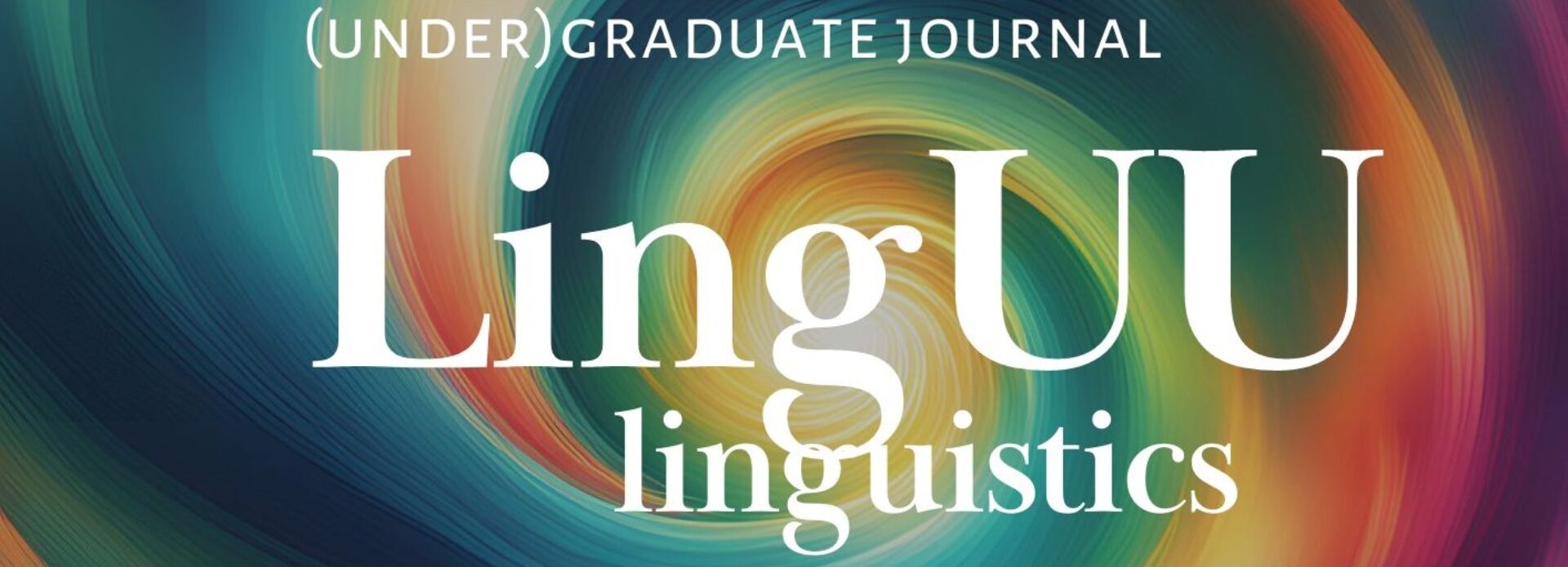Tag: linguu61
Daily Linguist 6.1
LingUU 6.1
Download the complete LingUU 6.1 here.
Editors-in-Chief: Carolin Tyrchan, Victoria Reshetnikova
Contents
Research
Rendl, L. (2022). Language as a Tool of Embodiment: a case study of inclusive and gender-neutral writings in French. LingUU Journal, 6(1), pp. 4-17.
Rijlaarsdam, C. (2022). Categorizing disagreements in the SNLI Corpus: an exploratory study. LingUU Journal, 6(1), pp. 18-28.
Irmawati, M., Remijnse, L., and Gunal, A. (2022). Dutch-English cognates and word class do not facilitate the processing of intra-sentential switches: a critical replication study. LingUU Journal, 6(1), pp. 29-38.
Vinke, J. (2022). Voice and Length in Dutch Fricatives. LingUU Journal, 6(1), pp. 39-53.
Zimianiti, E. (2022). Is semantic memory the winning component in second language teaching with Accelerative Integrated Method (AIM)?. LingUU Journal, 6(1), pp. 54-62.
Intern Extern Zimianiti, E., van den Berg, M., and Reshetnikova, V. (2022). Research Internships in Times of a Global Pandemic, Part 3. LingUU Journal, 6(1), pp. 63-65.
The Daily Linguist Recommendations for linguistics students. Read it here (pp. 66).
Is Semantic Memory the winning component in Second Language Teaching with Accelerative Integrated Method (AIM)?
Author: Eleni Zimianiti
Source: LingUU Journal, Vol. 6, Iss. 1, pp. 54-62
Year: 2022
Published by: LingUU Journal
Abstract
This paper constitutes a research proposal based on Rousse-Malpalt’s
(2019) dissertation, which extensively examines the effectiveness of the
Accelerative Integrated Method (AIM) in second language (L2) learning.
Although it has been found that AIM is a greatly effective method in comparison with non-implicit teaching methods, the reasons behind its success and effectiveness are yet unknown. As Semantic Memory (SM) is the component of memory responsible for the conceptualization and storage of knowledge, this paper sets to propose an investigation of its role in the learning process of AIM and provide with insights as to why the embodied experience of learning with AIM is more effective than others. The tasks proposed for administration take into account the factors of gestures being related to a learner’s memorization process and Semantic Memory. Lastly, this paper provides with a future research idea about the learning mechanisms of sign languages in people with hearing deficits and healthy population, aiming to indicate which brain mechanisms benefit from the teaching method of AIM and reveal important brain functions for SLA via AIM.
Keywords
second language acquisition; semantic memory; embodied learning; gestures; brain activation
Voice and Length in Dutch Fricatives
Author: Joeri Vinke
Source: LingUU Journal, Vol. 6, Iss. 1, pp. 39-53
Year: 2022
Published by: LingUU Journal
Abstract
Fricatives are often described as sensitive to devoicing. In Dutch for example they lose voice in final devoicing and do not participate as assimilator in regressive voice assimilation. In a classical rule-based analysis of these Dutch voice phenomena (as described in Zonneveld (2007)) the unwillingness of fricatives to share their voice feature must be described using rules of both progressive and regressive voice assimilation. This analysis crucially relies on an underlying voice distinction. In this paper, I will argue that relying on a distinction in length leads to a simpler analysis and better description of the data. Following up on work by Van Oostendorp (2002), I will argue that taking this approach provides a more minimal account of the behaviour of Dutch fricatives in assimilation contexts as well as providing us with a clear solution to a distributional gap in the phonotactics of short/long vowels and voiced/voiceless fricatives in rhymes that was described by Van der Hulst (1985).
Keywords
voice; fricative length; devoicing; phonotactics
Categorizing Disagreements in the SNLI Corpus: an exploratory study
Author: Carla Rijlaarsdam
Source: LingUU Journal, Vol. 6, Iss. 1, pp. 18-28
Year: 2022
Published by: LingUU Journal
Abstract
This paper explores annotator disagreements in the Stanford Natural Language Inference (SNLI) Corpus (Bowman et al., 2015a) to gain more insight into how humans make language inferences. The aim of the exploration is to find patterns in the annotator disagreements and to categorize them. This categorization leads to an explanation of the disagreements, and this information can be used to train Natural Language Processing (NLP) models of any kind. The annotation process of disagreements can be divided into three phases, namely, the initial subset to create the first categories, an additional set to sharpen the categories and create the first guidelines, and a final set judged by other annotators to create the second version of the guidelines. The latest version of the guidelines can be used as a starting point for further research to enable more knowledge about human inferences. This exploratory study investigated 75 disagreement pairs in total.
Keywords
computational linguistics; language inferences; human inferences; meaning; annotators
Appendix
Read the appendix here.
Language as a tool of embodiment: A case study of inclusive and genderneutral writings in French
Author: Liv Rendl
Source: LingUU Journal, Vol. 6, Iss. 1, pp. 4-17
Year: 2022
Published by: LingUU Journal
Abstract
Gender plays an important role in language not only in a purely grammatical sense, as some languages like French or German have grammatical gender, but also in a personal sense. By using gendered pronouns, gendered adjectives or gendered verb forms, we allow for a greater understanding of the person we are talking about (be it ourselves or someone else). This relates to Butler’s claim of gender being a performative act (1988). The presented case study compiles a small corpus of examples
of the linguistic phenomena occurring in French: the Écriture Inclusive (Inclusive Writing) and the Écriture Neutre (Gender-Neutral writing) (the latter being more specific to the francophone queer and feminist community) based on the works by Alpheratz (2018, 2019) and Greco (2019). Its goal is to take an in-depth look at the meaning and implications of each of those writing forms, analysing it under the light of Butler’s argumentation (1988) of gender as a performative act, as well as how they allow to put words onto a (social) reality.
Keywords
French; gender-neutral writing; inclusive writing; sociolinguistics; word meaning
Appendix
Download the appendix here.
Dutch-English cognates and word class do not facilitate the processing of intra-sentential switches: A critical replication study
Authors: Mila Irmawati, Levi Remijnse and Ayse Gunal
Source: LingUU Journal, Vol. 6, Iss. 1, pp. 29-38
Year: 2022
Published by: LingUU Journal
Abstract
This study investigates the effect of the word class of cognates on the cognitive cost involved in switching from L1 Dutch to L2 English in successive bilinguals. In our Self-Paced Reading (SPR) Task, 33 participants
were presented with Dutch sentences with an intra-sentential switch to
English occurring after a cognate. Our results showed no facilitation effect
of cognate types, word class, or its interaction on easing the transition. It
is also possible that SPR is not a suitable task to measure the cognitive
cost of cognates during the code-switching process. Future studies on the
facilitation effect of cognates’ word classes should consider other or additional methods as well.
Keywords
cognates; word class; code-switching; self-paced reading


